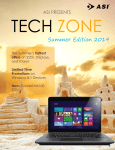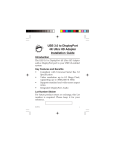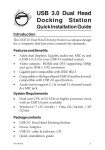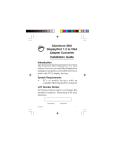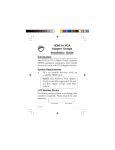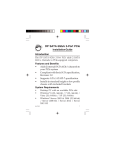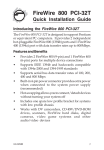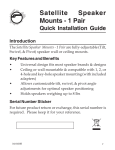Download Siig JU-DV0511-S1
Transcript
SuperSpeed USB 3.0 Display Adapter Installation Guide Introduction The SuperSpeed USB 3.0 Display Adapter allows you to connect a display to your desktop or notebook PC and use it as an additional larger display for your main screen. Key Features and Benefits • • • • • • • 04-0912A Supports standard and widescreen (16:9 & 16:10) aspect ratios Connect up to 6 adapters per system Video memory: 512MB Compliant with SuperSpeed USB 3.0 and backwards compatible with USB 2.0 specification Supports 2048 x 1152 (16:9 ratio) and 1920 x 1200 (16:10 ratio) resolutions Display modes: Primary, Extend and Mirror USB bus powered – no power adapter required 1 System Requirements • • • 2.0 GHz Dual Core CPU with an available USB 2.0/3.0 port (USB 3.0 recommended) Windows® 8 (32-/64-bit) / 7 (32-/64-bit) / Vista (32-/64-bit) / XP (32-bit) Mac OS® X v10.6 and later Package Contents • • • • SuperSpeed USB 3.0 Display Adapter Driver CD USB 3.0 cable (Type A to Micro B) Installation guide Layout JU-H20311-S1 USB 3.0 connector LED HDMI out Figure 1: SuperSpeed USB 3.0 to HDMI Adapter 2 JU-DV0511-S1 USB 3.0 connector LED VGA out Figure 2: SuperSpeed USB 3.0 to DVI Adapter JU-VG0511-S1 USB 3.0 connector LED DVI out Figure 3: SuperSpeed USB 3.0 to VGA Adapter Windows Software Installation Make sure the proper driver for your graphics card is installed, the SuperSpeed USB 3.0 Display Adapter is not designed to work with Windows' Standard VGA Graphics Adapter driver. Important: Do not plug the SuperSpeed USB 3.0 Display Adapter into the computer until instructed to do so. 3 1. 2. 3. 4. 5. Insert the driver CD. At the autoplay CD driver window, double click Setup. Or press Windows key and R, type D:\Setup.exe in the Run window, then click OK. (Change D: to match your CD/DVD-ROM drive letter) Click Yes or Allow at the User Account Control. Skip this step if not prompted. Connect your second monitor to the SuperSpeed USB 3.0 to Display Adapter and turn it on, then plug the SuperSpeed USB 3.0 Display Adapter into the computer. (USB 3.0 recommended) Restart the computer. To Verify Windows Installation 1. 4 Go to Device Manager to verify installation. For Windows 8 / Windows 7 / Windows XP: Right click Computer or My Computer, click Manage, then click Device Manager. For Windows Vista: Right click Computer, click Manage, click Continue, then click Device Manager. 2. Double click USB Display Adapters. For SuperSpeed USB 3.0 to HDMI Adapter: USB 3.0 to HDMI Adapter should be displayed. For SuperSpeed USB 3.0 to VGA Adapter: USB 3.0 to VGA Adapter should be displayed. For SuperSpeed USB 3.0 to DVI Adapter: USB 3.0 to DVI Adapter should be displayed. Uninstalling the Adapter Driver Windows 8 / Windows 7 1. 2. 3. 4. 5. For Windows 8, double click Control Panel on desktop. For Windows 7, click Start, and click Control Panel. Click Programs, and click Programs and Features. Select DisplayLink Graphics, then click Uninstall. Click Yes, Yes, then click OK. Click Yes to complete uninstalling the driver. 5 Windows Vista 1. 2. 3. 4. Click Start, and click Control Panel. Click Classic View, double click Programs and Features. Select DisplayLink Graphics, then click Uninstall, then click Yes. Click Allow, then click Yes to complete uninstalling the driver. Windows XP 1. 2. 3. 4. Click Start, and Control Panel. Double click Add/Remove Programs. Select DisplayLink Graphics, click Remove, then click Yes. Click Yes to complete uninstalling the driver. Windows Display Utility After successful driver installation, a display utility icon will appear in the taskbar. This display utility allows you to quickly change the viewing modes and resolutions. Access the utility by clicking the icon. 6 Viewing Modes Several options to change the setups of your display: • Screen Resolution: Displays a list of available resolutions. • Screen Rotation: Normal - No rotation is applied to the SuperSpeed USB 3.0 Display Adapter display. Rotated Left - Rotates the extended or mirrored display by 270 degrees. Rotated Right - Rotates the extended or mirrored display by 90 degrees. Upside-Down - Rotates the extended or mirrored display by 180 degrees. • Extend to: Right - Extends the display to the right of the main display. Left - Extends the display to the left of the main display. Above - Extends the display above of the main display. Below - Extends the display below the main display. 7 • • • • • • 8 Extend (default): This mode extends your desktop for easy viewing of multiple windows. Windows will move off the primary display from the right side and enter the extended display from the left. Set as Main Monitor: This mode, makes the SuperSpeed USB 3.0 Display Adapter the main display adapter in the system. Mirror: In this mode, the SuperSpeed USB 3.0 Display Adapter will mirror your desktop. You will see the same image on both monitors. Off: This setting turns off the SuperSpeed USB 3.0 Display Adapter. Optimize for Video (not available in Windows XP): Configures the secondary display for optimum full screen video performance output. Note: Text may appear less clear. Fit to TV: Adjust the size of the Windows desktop when the Windows desktop does not completely appear on the TV. Using Windows Display Properties (WDP) Note: Not all of the WDP functions are available in Windows Vista. Instead of using the display utility, you can use the embedded Windows Display Properties (WDP) to change view modes and resolutions. Following the instructions below to access the WDP functions: Position the mouse anywhere on the Windows Desktop, For Windows 8 / Windows 7: Right click and select Screen Resolution. For Windows Vista: Right click and select Personalize, then click Display Settings. For Windows XP: Right click then select Properties. WDP allows you to rotate, duplicate or extend screens as well as modify screen resolution. • Display: Use the drop down list to select a display to be configured. • Resolution: Use the drop down list and user the slider to choose a resolution. 9 • • • 10 Orientation: Landscape - Sets the display to landscape view. Portrait - Sets the display to portrait mode. Landscape (flipped) - Sets the display to upside down landscape mode. Portrait (flipped) - Sets the display to upside down landscape mode. Multiple displays: Duplicates these displays - Reproduces the main display on the second display. Extend these displays - Extends the main display onto the secondary display. Show Desktop only on 1 - The desktop appears on the display marked 1. The display marked 2 becomes blank. Show Desktop only on 2 - The desktop appears on the display marked 2. The display marked 1 becomes blank. Make this my main display: When you check the box, it will make your SuperSpeed USB 3.0 Display Adapter the main display adapter in the system. • Make sure the secondary monitor is selected before choosing this option. Display Positions: To move the position of a display, click and hold the display you wish to move then drag it to the desired position. (As Figure 4 in the next page.) The display will be highlighted with a blue border while you are moving the display to its new position. Select a display and drag to a preferred position. Figure 4: WDP functions 11 Windows Shortcut Press Windows key and P to bring up the menu and choose a desirable mode. (Available in Windows 8 and Windows 7 only) * The image may vary under different OS. However, the functions are the same. Figure 5: Shortcut Video Playback in Extended Mode If the video or DVD playback quality is poor or low performance in the extended mode, please playback on the primary monitor instead of the add-on monitors. Mac OS Driver Installation 1. 2. 3. 12 Connect your second monitor to the SuperSpeed USB 3.0 Display Adapter and turn it on, then plug the SuperSpeed USB 3.0 Display Adapter to an available USB port. Insert driver CD. Double click Driver CD icon on the Desktop. 4. 5. 6. 7. 8. 9. 10. 11. Double click Mac OS X 10.6-10.8 folder. Double click DisplayLink_MacOSX_ V2.0.dmg At the DisplayLink Installer, double click DisplayLink Software Installer.pkg. At the Introduction, click Continue. At the License, click Continue, then click Agree. At the Installation Type, click Change Install Location if you want to change the default saving folder; otherwise, click Install. Type in Name and Password, click OK or Install Software, then click Continue Installation. Click Restart to complete the installation. To Verify Driver Installation 1. 2. 3. Double click the correspond Mac drive icon. Go to System/Library/Extensions folder. If the files DisplayLink....kext in the Extension folder, the SuperSpeed USB 3.0 Display Adapter is installed successfully. 13 To Uninstall the Driver 1. 2. 3. 4. 5. 6. 7. Insert the driver CD. Double click Driver CD icon on the Desktop. Double click Mac OS X 10.6-10.8 folder. Double click DisplayLink_MacOSX_ V2.0.dmg. Double click DisplayLink Software Uninstaller, then Select Uninstall. Type in the password, then click OK. Click Restart to complete uninstalling the driver. Mac Display Utility After successful driver installation, an icon will appear in the taskbar. Access the menu by clicking the icon and select Display Preferences. Or you can go to System Preferences and click Displays. Setting the Display Resolutions Select an available resolution from the Display Preferences window. The resolutions available depend on both the SuperSpeed USB 3.0 Display Adapter enabled product and the capabilities of the connected display. 14 Rotating a Display Configure the orientation using the Rotate drop down, see Figure 6 in the next page. Select the appropriate angle of rotation to match your display's set up. Select from the Resolution drop down list to change the display resolution Select from the Rotate drop down list if you want to rotate your display. Figure 6 Setting the Display to Mirror/Extend Mode As Figure 7 in the next page, check the Mirror Displays box on the Arrangement pane to enable the mirror mode. Uncheck the box to set the display to extend mode. 15 Change the main display by simply dragging the white menu bar between the displays. Check the Mirror Displays box to enable the mirror mode; uncheck it to go back to the default setting (extend mode). Figure 7 Changing the Main Display As Figure 7, you can change the main display by moving the Menu Bar between displays. Changing the main display affects where new windows appear and the position of the Dock. 16 Frequently Asked Questions Q1: Why won't my DVD player work when I move it over to the extended display? A1: Some DVD playback software packages do not support playing on a second display adapter. Q2: How come my open window will not move over to the extended display? A2: Restore down the open window before moving it over the the extended display, also make sure the open window is moved completely over onto the extended display. Q3: There are lines running horizontally up and down my screen or the screen is distorted. A3: This is due to a low or unsupported refresh rate setting. You can change this in Display Properties/Settings/Advanced/Monitor. Noted not to select the SuperSpeed USB 3.0 Display Adapter and not set the refresh rate higher than what your monitor can support. 17 Q4: Why my mouse can't return to the primary monitor when removing the adapter while in extended mode? A4: In some cases, when removing the adapter while in extended mode, the desktop will still be paired to be add-on monitor(s) and the mouse cursor may not return to the primary monitor. If this happens, connect the addon monitor(s) and adapter again or keep moving the mouse. Q5: Why can't I make the SuperSpeed USB 3.0 Display Adapter the primary display? A5: Some video cards ship their product with a utility that prevents other video cards from being set as the primary video card. Check the bottom right hand corner of the taskbar for the utility. Disable the utility before switching the SuperSpeed USB 3.0 Display Adapter to be the primary display. 18 Technical Support and Warranty QUESTIONS? SIIG’ s Online Support has answers! Simply visit our web site at www.siig.com and click Support. Our online support database is updated daily with new drivers and solutions. Answers to your questions could be just a few clicks away. You can also submit questions online and a technical support analyst will promptly respond. SIIG offers a 5-year manufacturer warranty with this product. This warranty covers the original purchaser and guarantees the product to be free of any defects in materials or workmanship for five (5) years from the date of purchase of the product. SIIG will, at our discretion, repair or replace (with an identical product or product having similar features and functionality) the product if defective in materials or workmanship. This warranty gives you specific legal rights, and you may also have other rights which vary from state to state. Please see our web site for more warranty details. If you encounter any problems with this product, please follow the procedures below. A) If it is within the store's return policy period, please return the product to the store where you purchased from. B) If your purchase has passed the store's return policy period, please follow the steps below to have the product repaired or replaced. Step 1: Submit your RMA request. Go to www.siig.com, click Support, then REQUEST A PRODUCT REPLACEMENT to submit a request to SIIG RMA or fax a request to 510-657-5962. Your RMA request will be processed, if the product is determined to be defective, an RMA number will be issued. Step 2: After obtaining an RMA number, ship the product. • Properly pack the product for shipping. All accessories that came with the original package must be included. • Clearly write your RMA number on the top of the returned package. SIIG will refuse to accept any shipping package, and will not be responsible for a product returned without an RMA number posted on the outside of the shipping carton. • You are responsible for the cost of shipping to SIIG. Ship the product to the following address: SIIG, Inc. 6078 Stewart Avenue Fremont, CA 94538-3152, USA RMA #: • SIIG will ship the repaired or replaced product via Ground in the U.S. and International Economy outside of the U.S. at no cost to the customer. 19 About SIIG, Inc. Founded in 1985, SIIG, Inc. is a leading manufacturer of IT connectivity solutions (including Serial ATA and Ultra ATA Controllers, FireWire, USB, and legacy I/O adapters) that bridge the connection between Desktop/ Notebook systems and external peripherals. SIIG continues to grow by adding A/V and Digital Signage connectivity solutions to our extensive portfolio. SIIG products offer comprehensive user manuals, many user-friendly features, and are backed by an extensive manufacturer warranty. High quality control standards are evident by the overall ease of installation and compatibility of our products, as well as one of the lowest defective return rates in the industry. SIIG products can be found in computer retail stores, mail order catalogs, through major distributors, system integrators, and VARs in the Americas and the UK, and through e-commerce sites. PRODUCT NAME SuperSpeed USB 3.0 Display Adapter FCC RULES: TESTED TO COMPLY WITH FCC PART 15, CLASS B OPERATING ENVIRONMENT: FOR HOME OR OFFICE USE FCC COMPLIANCE STATEMENT: This device complies with part 15 of the FCC Rules. Operation is subject to the following two conditions: (1) This device may not cause harmful interference, and (2) this device must accept any interference received, including interference that may cause undesired operation. THE PARTY RESPONSIBLE FOR PRODUCT COMPLIANCE SIIG, Inc. 6078 Stewart Avenue Fremont, CA 94538-3152, USA Phone: 510-657-8688 SuperSpeed USB 3.0 Display Adapter is a trademark of SIIG, Inc. SIIG and the SIIG logo are registered trademarks of SIIG, Inc. Microsoft and Windows are registered trademarks of Microsoft Corporation. All other names used in this publication are for identification only and may be trademarks of their respective owners. October, 2013 Copyright © 2013 by SIIG, Inc. All rights reserved.




















